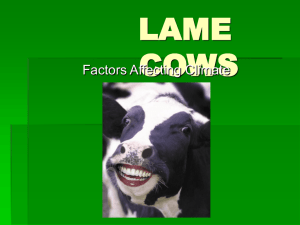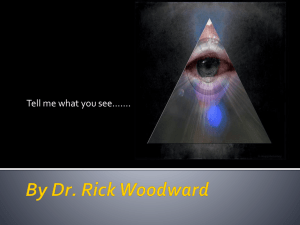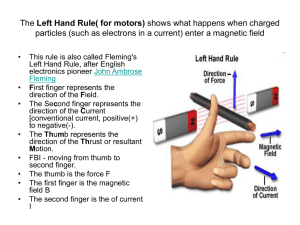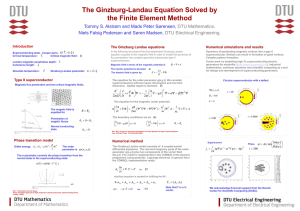UML Lecture 7 - University of Massachusetts Lowell
advertisement
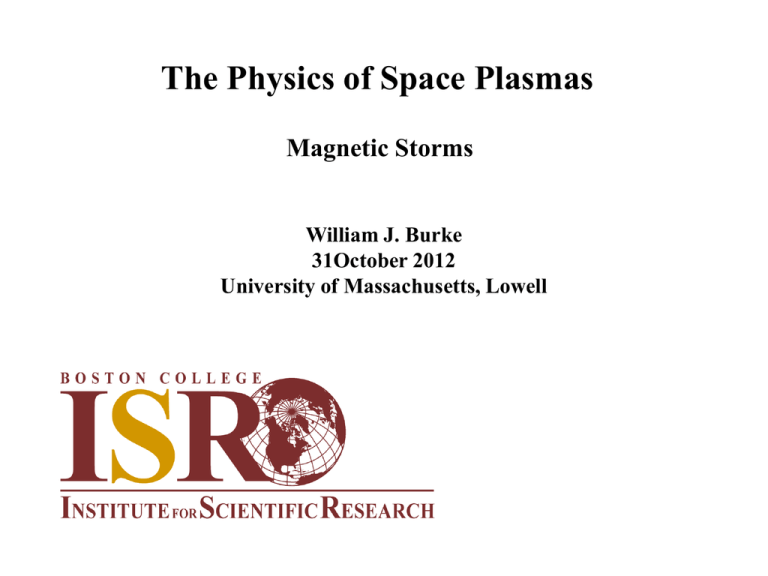
The Physics of Space Plasmas Magnetic Storms William J. Burke 31October 2012 University of Massachusetts, Lowell Magnetic Storms Lecture 7 • Historical background: - Dessler-Parker-Sckopke - Burton-Russell-McPherron relationships • Electric fields in the inner magnetosphere: penetration, shielding and over-shielding. - Single particle approach: the Volland-Stern model - Fluid/multi-fluid approach: The Rice Convection model - Two crises: (1) too much shielding (June 1991 storm), and (2) electric field saturation (Bastille Day Storm) - Tsyganenko: Magnetic inflation and contributors to Dst - Siscoe-Hill and revised Volland-Stern models • Love and Gannon: Dst movies • Transmission line analogy Magnetic Storms Magnetic Storms: a brief history: • Alexander von Humboldt coined the term “magnetic storm” after watching aurorae and magnetic deflection over Berlin in Dec.21, 1806. • Richard Carrington: witnesses white light flare August 28, 1859 followed by magnetic storm on the next day: aurorae over Havana. • Kristin Birkeland: After 1902-1903 campaign distinguished between polar elementary storms (substorms) and equatorial perturbations. • Sydney Chapman: phases of magnetic storms • Alex Dessler & Gene Parker: (1959) ERC H at the Earth’s surface. • Masahisa Sugiura: Dst stations and hourly index to calibrate storms • Burton et al. (1975): Predict Dst from solar wind/IMF Magnetic Storms Stormtime E-fields in Inner Magnetosphere: • E-fields are the only force that can accelerate charged particles • In general: F mx F x mx x m d 2 d x K 2 dt dt • Consider a charge particle with an equatorial pitch angle of 90 in the presence of a dawn-to-dusk electric field E = - . Since VG dK qE V qE (VEB VG ) qE VG q VG dt qB 2 ( B B) dK ( B B) ( E B) qE VG E B VE B 2 2 dt B B Magnetic Storms The Volland-Stern single-particle model: • Here we use a version of the V-S model formulated by Ejiri, JGR, 83, 4798, 1978. • Consider the electric potential (R, f) in the magnetospheric equatorial plane as a superposition of a co-rotation and “externally imposed” potentials B0 RE3 ( R, f ) C ( R) M ( R, f ) CRg Sinf R • The corotation potential B0RE2 91 kV . C is a constant determined by boundary conditions and g is a fitting parameter whose physical meaning is addressed below. • We will use both cylindrical (R , f) and Cartesian (XGSM, Y GSM) coordinates. Rˆ Cosf Sinf Xˆ fˆ Sinf Cosf Yˆ Xˆ Cosf Yˆ Sinf Sinf Rˆ Cosf fˆ •Assume that E is in the dawn-dusk (+ YGSM) direction ˆ1 E ( R, f ) rˆ f ( R, f ) R f R Magnetic Storms The Volland-Stern single-particle model: B0 RE3 E(R,f ) E C (R) E M (R,f ) rˆ CRg 1 g Sinf rˆ Cosffˆ 2 R At some point RS = RE LS along the dusk meridian (f = p/2) the inward pointing EC exactly cancels the outward directed EM allowing us to calculate C B0 RE3 B0 RE3 C g 1 g RS g ( RE LS )g 1 g 1 B0 R 1 R 1 Sinf ( R, f ) R g RS 3 E B0 RE3 E(R,f ) R2 g 1 R g 1 R 1 ˆ 1 Sinf rˆ Cosff RS g RS g 1 91kV 1 L 1 Sinf ( L, f ) L g LS Magnetic Storms The Volland-Stern single-particle model: g 1 g 1 1 L mV 1 L ˆ E(L,f ) 15 2 1 Sinf rˆ Cosff m L LS g LS At the stagnation point LS the potential is p 91 1 ( LS , ) kV 1 2 LS g Since the last closed equipotential touches LS => calculate locus of this potential 91kV ( LA , f ) LS LA LS 1 91kV 1 g LA g 1 LA (f ) Sinf 1 L g 1 1 A Sinf g LS LA (g 1) g 0 LS LS 2 f 3p / 2 1 Cos g 2 • LA(f) gives shape of zero-energy Alfvén boundary (ZEAB) • Still don’t know what g means or how to relate EM to the interplanetary medium. Magnetic Storms The Volland-Stern single-particle model: At the magnetopause on the dawn (LY, 3p/2) and dusk (LY, p/2) the potentials are approximately PC/2 and - PC/2, respectively. LY 1.5 LX g 1 (kV ) p 91kV L Y M ( LY , ) PC B02 9.6 2 g LY LSg 2 LX 6 0 PSW 6 PSW (nPa) 1 g 1 182 6 P (nPa) L 14.4 / LSg LY Y SW g L ( kV ) Y PC g 91kV PC (kV ) L ( L, f ) Sinf L 2 LY E(L,f ) 91(kV ) ˆ PC (kV ) L R 2 RE L 2 RE LY LY Average E across magnetosphere g 1 g Sinf Rˆ Cosffˆ 1 Yˆ Magnetic Storms Rice Convection Model: (Harel et al., JGR 1981) Vasyliunas (1969, 1970) B p j 2 B j 0 p B j|| 1 1 j 2 s B B B B Bi ds ˆ j|| (p Be ) 2 Be B Magnetic Storms Main Phase Electric fields and particles measured by CRRES Magnetic Storms Magnetic Storms Electric field and particle boundaries sampled by DMSP F8 and CRRES Magnetic Storms Magnetosphere simulation at 22:00 UT on 6 April 2000 Tsyganenko, N. A., H. J. Singer, and J. C. Kasper, Storm-time distortion of the inner magnetosphere: How severe can it get? J. Geophys. Res., 108 (A5), 1209, 2003. Magnetic Storms Magnetosphere simulation at 08:00 UT on 31 March 2001 Magnetic Storms Magnetic Storms Model validation with F13 & F15 B Z Y Siscoe et al. (2002), Hill model of transpolar saturation: Comparisons with MHD simulations, JGR 107, A6, 1025. B Ober et al. (2003) , Testing the Hill model of transpolar potential saturation, JGR, 108, (A12), Magnetic Storms MRC: ISM Simulations with IMF BZ = -2 and -20 nT S = 1600 PSW 0.33 (nPa) / S PC = I S / (I + S ) Ober et I = 0 + LG V BT Sin2 (q/2) Magnetic Storms Love, J. J., and J. L. Gannon (2010), Movie‐maps of low‐latitude magnetic storm disturbance, Space Weather, 8, S06001, doi:10.1029/2009SW000518. Magnetic Storms November 2003 storm Magnetic Storms Magnetic Storms Magnetic Storms Magnetic Storms Electric field Scaling: • Kelley et al. (2003), Penetration of the solar wind electric field into the magnetosphere/ionosphere system, GRL., 30(4), 1158. compared electric measured with the Jicamarca ISR fields with the Y component of IEF (VBZ). • Found the electric field in the equatorial ionosphere is one 15th of the electric field in the solar wind • It seemed useful to compare eVS with IEFY Magnetic Storms Magnetic Storms Huang, C. Y. and W. J. Burke (2004) Transient sheets of field aligned currents observed by DMSP during the main phase of a magnetic superstorm, JGR, 109, A06303. Magnetic Storms “Measured” Poynting Flux Transmission line model EY EYi EYr EYr REYi R S A SP S A SP S|| S A 1/ 0VAR BZ BZi BZr EY BZ 0 EYi RE E VAS Yr Yi BZi BZr BZr BZr R BZi BZ BZi BZr EY EYi EYr 1 1 R 1 S P VAR 0 S P VAS 1 R VAS S A VAS EY BZ 0 (1 R2 ) S||i (1 R2 ) S||i S||r Aurorae and High-Latitude Electrodynamics Nopper and Carovillano, GRL 699, 1978 Region 1 = 106 A Region 2 = 0 A Region 1 = 106 A Region 2 = 3105 A Wolf, R. A., Effects of Ionospheric Conductivity on Convective Flow of Plasma in the Magnetosphere, JGR, 75, 4677, 1970.

